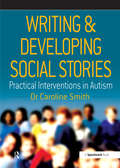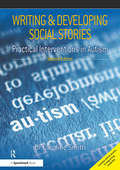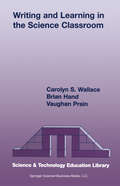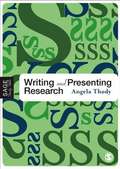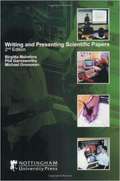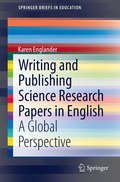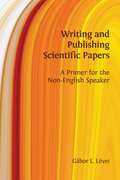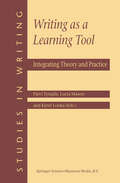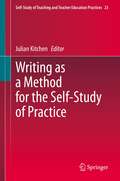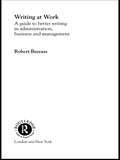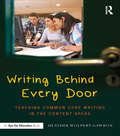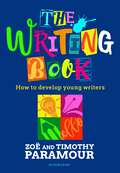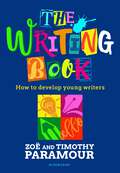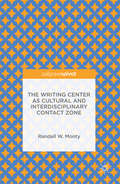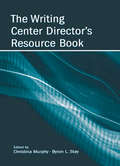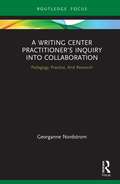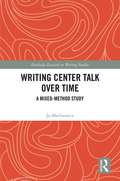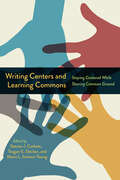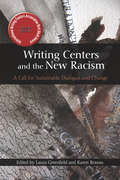- Table View
- List View
Writing and Developing Social Stories
by Caroline SmithThis practical resource provides an introduction to the theory and practice of writing social stories. In addition, there are examples of successful stories to use as guides, as well as information and photocopiable resources for delivering training on the use of social stories. Based on detailed work carried out in homes, schools and pre-schools, this book offers practical support to anyone meeting the needs of a child or young adult with an autistic spectrum disorder. Social stories are short stories intended for children with autism to help them understand their social world and behave appropriately within it. The stories provide clear, concise and accurate information about what is happening in a specific situation, outlining both why it is happening and what a typical response might be. It is written by those directly supporting a child with autism and only successful stories are included in the book. The stories are infinitely flexible and adaptable to an individual child in an individual social situation. It covers children aged 3 to 16.
Writing and Developing Social Stories Ed. 2: Practical Interventions in Autism
by Caroline SmithThis practical resource provides an introduction to the theory and practice of writing social stories. In addition, there are examples of successful stories to use as guides, as well as information and photocopiable (and downloadable) resources for delivering training on the use of social stories. Based on detailed work carried out in homes, schools and pre-schools, this book offers practical support to anyone meeting the needs of a child or young adult with an autistic spectrum disorder, and with staff supporting adults with autism. Social stories are short stories intended for children and adults with autism to help them understand their social world and behave appropriately within it. The stories: provide clear, concise and accurate information about what is happening in a specific situation, outlining both why it is happening and what a typical response might be; are written by those directly supporting children or adults with autism and only successful stories are included in the book; are infinitely flexible and adaptable to an individual child in an individual social situation. FEATURES: This 2nd edition has been thoroughly revised and updated throughout. It also now contains: brand new stories including examples for use by parents at home; brand new section on mental health; and, additional stories for use with adults with autism.
Writing and Developing Social Stories Ed. 2: Practical Interventions in Autism
by Caroline SmithThis practical resource provides an introduction to the theory and practice of writing social stories. In addition, there are examples of successful stories to use as guides, as well as information and photocopiable (and downloadable) resources for delivering training on the use of social stories. Based on detailed work carried out in homes, schools and pre-schools, this book offers practical support to anyone meeting the needs of a child or young adult with an autistic spectrum disorder, and with staff supporting adults with autism. Social stories are short stories intended for children and adults with autism to help them understand their social world and behave appropriately within it. The stories: provide clear, concise and accurate information about what is happening in a specific situation, outlining both why it is happening and what a typical response might be; are written by those directly supporting children or adults with autism and only successful stories are included in the book; are infinitely flexible and adaptable to an individual child in an individual social situation. FEATURES: This 2nd edition has been thoroughly revised and updated throughout. It also now contains: brand new stories including examples for use by parents at home; brand new section on mental health; and, additional stories for use with adults with autism.
Writing and Learning in the Science Classroom (Contemporary Trends and Issues in Science Education #23)
by Carolyn S. Wallace Brian B. Hand Vaughan PrainThis volume is of interest to science educators, graduate students, and classroom teachers. The book will also be an important addition to any scholarly library focusing on science education, science literacy, and writing. This book is unique in that it synthesizes the research of the three leading researchers in the field of writing to learn science: Carolyn S. Wallace, Brian Hand, and Vaughan Prain. It includes a comprehensive review of salient literature in the field, detailed reports of the authors' own research studies, and current and future issues on writing in science. The book is the first to definitely answer the question, "Does writing improve science learning?". Further, it provides evidence for some of the mechanisms through which learning occurs. It combines both theory and practice in a unique way. Although primarily a tool for research, classroom teachers will also find many practical suggestions for using writing in the science classroom.
Writing and Presenting Research (PDF)
by Angela ThodyThis accessible and wide-ranging book is an invaluable introductory guide through the choices to be made when deciding how to report research. Writing and Presenting Research covers research written as theses and dissertations; chapters, books, reports and articles in academic, professional or general media such as newspapers; and also reviews the options for presenting research orally as lectures, keynotes, conference papers and even TV game shows. These forms of reporting research have well-established conventions for their formats, but they also have growing numbers of alternative possibilities. This has generated debate about what is, or is not, acceptable, and the aim of this book is to make this debate more manageable for those wanting to assess which of the conventional or alternative possibilities on offer is most appropriate for reporting their current research. Arranged in easily followed sections enlivened with checklists, style variations, examples and reflection points, Writing and Presenting Research has relevance to the social sciences, arts, humanities, natural and applied sciences and law and is an invaluable reference tool for new and experienced researchers alike. SAGE Study Skills are essential study guides for students of all levels. From how to write great essays and succeeding at university, to writing your undergraduate dissertation and doing postgraduate research, SAGE Study Skills help you get the best from your time at university. Visit the SAGE Study Skills website for tips, quizzes and videos on study success!
Writing and Presenting Scientific Papers: 2nd edition
by B MalmforsThe aim of this book is to provide guidelines for preparing papers and presentations so that your message can be transmitted clearly and concisely to the reader or listener. Techniques for improving your writing, literature searching and training students in communication are also discussed.
Writing and Publishing Science Research Papers in English: A Global Perspective (SpringerBriefs in Education)
by Karen EnglanderThis book provides a comprehensive review of the current knowledge on writing and publishing scientific research papers and the social contexts. It deals with both English and non-Anglophone science writers, and presents a global perspective and an international focus. The book collects and synthesizes research from a range of disciplines, including applied linguistics, the sociology of science, sociolinguistics, bibliometrics, composition studies, and science education. This multidisciplinary approach helps the reader gain a solid understanding of the subject. Divided into three parts, the book considers the context of scientific papers, the text itself, and the people involved. It explains how the typical sections of scientific papers are structured. Standard English scientific writing style is also compared with science papers written in other languages. The book discusses the strengths and challenges faced by people with different degrees of science writing expertise and the role of journal editors and reviewers.
Writing and Publishing Scientific Papers: A Primer for the Non-English Speaker
by Gábor L. LöveiGábor Lövei’s scientific communication course for students and scientists explores the intricacies involved in publishing primary scientific papers, and has been taught in more than twenty countries. Writing and Publishing Scientific Papers is the distillation of Lövei’s lecture notes and experience gathered over two decades; it is the coursebook many have been waiting for. The book’s three main sections correspond with the three main stages of a paper’s journey from idea to print: planning, writing, and publishing. Within the book’s chapters, complex questions such as ‘How to write the introduction?’ or ‘How to submit a manuscript?’ are broken down into smaller, more manageable problems that are then discussed in a straightforward, conversational manner, providing an easy and enjoyable reading experience. Writing and Publishing Scientific Papers stands out from its field by targeting scientists whose first language is not English. While also touching on matters of style and grammar, the book’s main goal is to advise on first principles of communication. This book is an excellent resource for any student or scientist wishing to learn more about the scientific publishing process and scientific communication. It will be especially useful to those coming from outside the English-speaking world and looking for a comprehensive guide for publishing their work in English.
Writing as a Learning Tool: Integrating Theory and Practice (Studies in Writing #7)
by KirstiLonka LuciaMason PäiviTynjäläThis book is an outstanding account of the current state of using writing in service of learning. It presents psychological and educational foundations of writing across the curriculum movement and describes writing-to-learn practices implemented at different levels of education. It provides concrete applications and ideas about how to enhance student learning by means of writing. It is useful for educators, curriculum developers, psychologists, cognitive scientists, writing researchers, and teachers.
Writing as a Method for the Self-Study of Practice (Self-Study of Teaching and Teacher Education Practices #23)
by Julian KitchenThis book focuses on the writing process in the self-study of teaching and teacher education practices. It addresses writing as an area in which teacher educators can develop their skills and represents how to write in ways that are compatible with self-study's orientations towards the inquiry, both personal and on practice. The book examines effective self-study writing with chapters written by experienced self-study practitioners. In addition to considering elements of writing as a method for the self-study of practice, it delves into the cognitive processes of real writers making explicit their writing practices. Practical suggestions are connected to the lived experiences of self-study practitioners making sense of their field through the process of writing. This book will be of interest to doctoral and novice self-study writers, and experienced authors seeking to develop their practice. It demonstrates that writing as a method of inquiry in self-study and beyond can be learned, modeled and taught.
Writing at Work: A Guide to Better Writing in Administration, Business and Management
by Robert BarrassMany employers complain about the poor communication skills of many young people seeking employment; and many people in employment are handicapped by the poor quality of their written work. While bad spelling, ineffective punctuation and faults in grammar create barriers between the writer and the reader, good English makes the reader feel at ease.The benefits of being a good writer at work are:Managers need to be able to communicate in order to get ideas across. If they cannot, they will be unable to make their viewpoint heard and they will be unable to influence customers, suppliers and colleagues as desiredIf you can write well, you will find that your views are given prominence over those of others. Effective communication, and that includes writing, is the key to career success and advancementThis book is for those who have difficulty in getting thoughts into words or their ideas across, as well as those who are satisfied with their writing but are ready to consider the possibility of improving it. It is all about the ways in which writing at work is important - helping the reader to observe, remember, think, plan, organise and communicate.
Writing at Work: A Guide to Better Writing in Administration, Business and Management
by Robert BarrassMany employers complain about the poor communication skills of many young people seeking employment; and many people in employment are handicapped by the poor quality of their written work. While bad spelling, ineffective punctuation and faults in grammar create barriers between the writer and the reader, good English makes the reader feel at ease.The benefits of being a good writer at work are:Managers need to be able to communicate in order to get ideas across. If they cannot, they will be unable to make their viewpoint heard and they will be unable to influence customers, suppliers and colleagues as desiredIf you can write well, you will find that your views are given prominence over those of others. Effective communication, and that includes writing, is the key to career success and advancementThis book is for those who have difficulty in getting thoughts into words or their ideas across, as well as those who are satisfied with their writing but are ready to consider the possibility of improving it. It is all about the ways in which writing at work is important - helping the reader to observe, remember, think, plan, organise and communicate.
Writing Behind Every Door: Teaching Common Core Writing in the Content Areas
by Heather Wolpert-GawronFor students to become college-ready writers, they must be exposed to writing throughout the school day, not just in English class. This practical book shows teachers in all subject areas how to meet the Common Core State Standards and make writing come alive in the classroom. Award-winning educator Heather Wolpert-Gawron provides effective and exciting ideas for teaching argument writing, informational writing, project-based writing, and writing with technology. Each chapter is filled with strategies, prompts, and rubrics you can use immediately. Special Features: A variety of writing strategies that work in any subject area Tips for developing meaningful prompts Diagrams and templates that you can use with your students Rubrics for assessing writing, as well as ideas for having students create their own rubrics Samples of student work in different formats Ideas for teaching students to break the Google homepage habit and conduct effective research Cross-curricular writing assignments for science, history, ELA, electives, and PE Suggestions for teaching summary writing, an essential academic skill Ideas for staff professional development on Common Core writing
Writing Behind Every Door: Teaching Common Core Writing in the Content Areas
by Heather Wolpert-GawronFor students to become college-ready writers, they must be exposed to writing throughout the school day, not just in English class. This practical book shows teachers in all subject areas how to meet the Common Core State Standards and make writing come alive in the classroom. Award-winning educator Heather Wolpert-Gawron provides effective and exciting ideas for teaching argument writing, informational writing, project-based writing, and writing with technology. Each chapter is filled with strategies, prompts, and rubrics you can use immediately. Special Features: A variety of writing strategies that work in any subject area Tips for developing meaningful prompts Diagrams and templates that you can use with your students Rubrics for assessing writing, as well as ideas for having students create their own rubrics Samples of student work in different formats Ideas for teaching students to break the Google homepage habit and conduct effective research Cross-curricular writing assignments for science, history, ELA, electives, and PE Suggestions for teaching summary writing, an essential academic skill Ideas for staff professional development on Common Core writing
The Writing Book: How to develop young writers
by Zoë Paramour Timothy ParamourEverything you need to teach writing in the primary classroom.The Writing Book helps you to break down the mysteries of written English into comprehensible steps that will get your students writing with confidence and flair.Written in Zoë and Timothy Paramour's funny, frank and reassuring style, this follow up to The Grammar Book gives teachers clear and systematic guidance about how to develop children's written English. It covers vocabulary, register, word order and text layout, as well as sentence structure, length and syntax. It explores the features of different genres, the ways we can play with language and the reader's expectations to make writing more engaging.The Writing Book gives teachers a clear and consistent language they can use with their students to offer meaningful feedback, especially when children's writing lacks flair and energy. Written by teachers for teachers, it provides tips, tricks, and adaptable resources to make teachers' lives easier. This book makes it easy for teachers to identify everything their students need to know to become confident, competent writers.
The Writing Book: How to develop young writers
by Zoë Paramour Timothy ParamourEverything you need to teach writing in the primary classroom.The Writing Book helps you to break down the mysteries of written English into comprehensible steps that will get your students writing with confidence and flair.Written in Zoë and Timothy Paramour's funny, frank and reassuring style, this follow up to The Grammar Book gives teachers clear and systematic guidance about how to develop children's written English. It covers vocabulary, register, word order and text layout, as well as sentence structure, length and syntax. It explores the features of different genres, the ways we can play with language and the reader's expectations to make writing more engaging.The Writing Book gives teachers a clear and consistent language they can use with their students to offer meaningful feedback, especially when children's writing lacks flair and energy. Written by teachers for teachers, it provides tips, tricks, and adaptable resources to make teachers' lives easier. This book makes it easy for teachers to identify everything their students need to know to become confident, competent writers.
The Writing Center as Cultural and Interdisciplinary Contact Zone
by Randall W. MontyWriting centers are complex. They are places of scholarly work, spaces of interdisciplinary interaction, and programs of service, among other things. With this complexity in mind, this book theorizes writing center studies as a function of its own rhetorical and discursive practices. In other words, the things we do and make define who we are and what we value. Through a comprehensive methodological framework grounded in critical discourse analysis, this book takes a closer look at prominent writing center discourses by temporarily shifting attention away from the stakeholders, work, locations, and scholarship of the discipline, and onto things—the artifacts and networks that make up the discipline. Through this approach, we can see the ways the discipline reinforces, challenges, reproduces, and subverts structures of institutional power. As a result, writing center studies can be seen a vast ecosystem of interconnectivity and intertextuality.
The Writing Center Director's Resource Book
by Christina Murphy Byron L. StayThe Writing Center Director's Resource Book has been developed to serve as a guide to writing center professionals in carrying out their various roles, duties, and responsibilities. It is a resource for those whose jobs not only encompass a wide range of tasks but also require a broad knowledge of multiple issues.The volume provides information on the most significant areas of writing center work that writing center professionals--both new and seasoned--are likely to encounter. It is structured for use in diverse institutional settings, providing both current knowledge as well as case studies of specific settings that represent the types of challenges and possible outcomes writing center professionals may experience. This blend of theory with actual practice provides a multi-dimensional view of writing center work.In the end, this book serves not only as a resource but also as a guide to future directions for the writing center, which will continue to evolve in response to a myriad of new challenges that will lie ahead.
The Writing Center Director's Resource Book
by Christina Murphy Byron L. StayThe Writing Center Director's Resource Book has been developed to serve as a guide to writing center professionals in carrying out their various roles, duties, and responsibilities. It is a resource for those whose jobs not only encompass a wide range of tasks but also require a broad knowledge of multiple issues.The volume provides information on the most significant areas of writing center work that writing center professionals--both new and seasoned--are likely to encounter. It is structured for use in diverse institutional settings, providing both current knowledge as well as case studies of specific settings that represent the types of challenges and possible outcomes writing center professionals may experience. This blend of theory with actual practice provides a multi-dimensional view of writing center work.In the end, this book serves not only as a resource but also as a guide to future directions for the writing center, which will continue to evolve in response to a myriad of new challenges that will lie ahead.
A Writing Center Practitioner's Inquiry into Collaboration: Pedagogy, Practice, And Research (Routledge Research in Writing Studies)
by Georganne NordstromThis book presents a model of Practitioner Inquiry (PI) as a systematic form of empirical research and provides a rationale for its suitability within a writing center context. Exploring the potential of writing centers as pedagogical sites that support research, the book offers an accessible model that guides both research and practice for writing center practitioners, while offering flexibility to account for their distinct contexts of practice. Responding to the increasing call in the field to produce empirical “RAD” (replicable, aggregable, data-driven) research, the author explores Practitioner Inquiry through explication of methodology and methods, a revisitation of collaboration to guide both practice and research, and examples of application of the model. Nordstrom grounds this research and scholarship in Hawaiʻi’s context and explores Indigenous concepts and approaches to inform an ethical collaborative practice. Offering significant contributions to empirical research in the fields of writing center studies, composition, and education, this book will be of great relevance to writing center practitioners, anyone conducting empirical research, and researchers working in tutor professionalization, collaboration, translingual literacy practices, and researchmethodologies.
A Writing Center Practitioner's Inquiry into Collaboration: Pedagogy, Practice, And Research (Routledge Research in Writing Studies)
by Georganne NordstromThis book presents a model of Practitioner Inquiry (PI) as a systematic form of empirical research and provides a rationale for its suitability within a writing center context. Exploring the potential of writing centers as pedagogical sites that support research, the book offers an accessible model that guides both research and practice for writing center practitioners, while offering flexibility to account for their distinct contexts of practice. Responding to the increasing call in the field to produce empirical “RAD” (replicable, aggregable, data-driven) research, the author explores Practitioner Inquiry through explication of methodology and methods, a revisitation of collaboration to guide both practice and research, and examples of application of the model. Nordstrom grounds this research and scholarship in Hawaiʻi’s context and explores Indigenous concepts and approaches to inform an ethical collaborative practice. Offering significant contributions to empirical research in the fields of writing center studies, composition, and education, this book will be of great relevance to writing center practitioners, anyone conducting empirical research, and researchers working in tutor professionalization, collaboration, translingual literacy practices, and researchmethodologies.
Writing Center Talk over Time: A Mixed-Method Study (Routledge Research in Writing Studies)
by Jo MackiewiczIn the last 15 to 20 years, writing centers have placed greater importance on tutor training, focusing on teaching tutors best practices in fostering student writers’ engagement and writing skills. Writing Center Talk over Time explores the importance of writing center talk and demonstrates the efficacy of tutor training. The book uses corpus-driven analysis and discourse analysis to examine the changes in writing center talk over time to provide a baseline understanding of the very heart of writing center work: the talk that unfolds between tutors and student writers. It is this talk that, at its best, motivates student writers to continue to improve their writing and scaffolds their learning and that makes tutors proud of the service that they provide. The methods and analysis of this study are intended to inform other researchers so that they may conduct further research into the efficacy of writing center talk.
Writing Center Talk over Time: A Mixed-Method Study (Routledge Research in Writing Studies)
by Jo MackiewiczIn the last 15 to 20 years, writing centers have placed greater importance on tutor training, focusing on teaching tutors best practices in fostering student writers’ engagement and writing skills. Writing Center Talk over Time explores the importance of writing center talk and demonstrates the efficacy of tutor training. The book uses corpus-driven analysis and discourse analysis to examine the changes in writing center talk over time to provide a baseline understanding of the very heart of writing center work: the talk that unfolds between tutors and student writers. It is this talk that, at its best, motivates student writers to continue to improve their writing and scaffolds their learning and that makes tutors proud of the service that they provide. The methods and analysis of this study are intended to inform other researchers so that they may conduct further research into the efficacy of writing center talk.
Writing Centers and Learning Commons: Staying Centered While Sharing Common Ground
Writing Centers and Learning Commons presents program administrators, directors, staff, and tutors with theoretical rationales, experiential journeys, and go-to practical designs and strategies for the many questions involved when writing centers find themselves operating in shared environments. The chapters comprehensively examine the ways writing centers make the most of sharing common ground. Directors, coordinators, administrators, and stakeholders draw on past and present attention to writing center studies to help shape the future of the learning commons and narrate their substantial collective experience with collaborative efforts to stay centered while empowering colleagues and student writers at their institutions. The contributors explore what is gained and lost by affiliating writing centers with learning commons, how to create sound pedagogical foundations that include writing center philosophies, how writing center practices evolved or have been altered by learning center affiliations, and more. Writing Centers and Learning Commons is for all stakeholders of writing in and across campuses collaborating on (by choice or edict), or wishing to explore the possibilities of, a learning commons enterprise. Contributors: Alice Batt, Cassandra Book, Charles A. Braman, Elizabeth Busekrus Blackmon, Virginia Crank, Celeste Del Russo, Patricia Egbert, Christopher Giroux, Alexis Hart, Suzanne Julian, Kristen Miller, Robby Nadler, Michele Ostrow, Helen Raica-Klotz, Kathleen Richards, Robyn Rohde, Nathalie Singh-Corcoran, David Stock
Writing Centers and the New Racism: A Call for Sustainable Dialogue and Change
by Greenfield, Laura; Rowan, KarenNoting a lack of sustained and productive dialogue about race in university writing center scholarship, the editors of this volume have created a rich resource for writing center tutors, administrators, and scholars. Motivated by a scholarly interest in race and whiteness studies, and by an ethical commitment to anti-racism work, contributors address a series of related questions: How does institutionalized racism in American education shape the culture of literacy and language education in the writing center? How does racism operate in the discourses of writing center scholarship/lore, and how may writing centers be unwittingly complicit in racist practices? How can they meaningfully operationalize anti-racist work? How do they persevere through the difficulty and messiness of negotiating race and racism in their daily practice? The conscientious, nuanced attention to race in this volume is meant to model what it means to be bold in engagement with these hard questions and to spur the kind of sustained, productive, multi-vocal, and challenging dialogue that, with a few significant exceptions, has been absent from the field.
